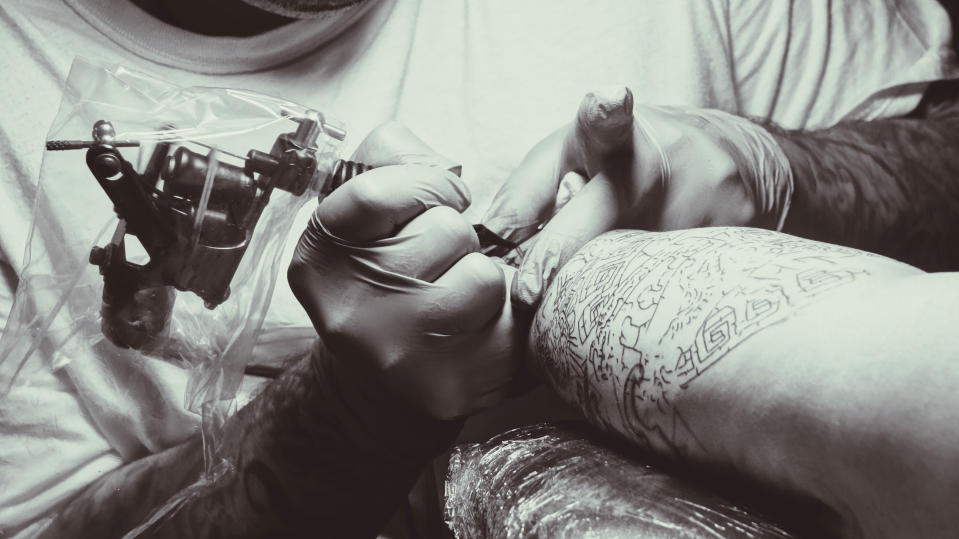Should you get a tattoo made with motorcycle exhaust?
Now that tattoos are about as mainstream as it gets, there are people searching for ways to make their body art just a little bit more unusual. On this week’s episode of the Viceland show Most Expensivist, host 2 Chainz got a small tat using a rare luxury item: Indian Motorcycle Ink, made with the exhaust from Carey Hart’s motorcycle. Tatted up as he is, even 2 Chainz wondered if putting something like that into his skin was safe.
“When I hear exhaust, I think emissions test,” he said warily as tattoo artist Ryan Jenkins at Hart & Huntington in Las Vegas got out his needle. The show explained how a tattoo artist collected carbon (a typical ink ingredient) from Hart running his motorcycle against a wall, sterilized it, and injected it into tattoo ink. Hart himself was the first to test it out, using it to get the name of his and Pink’s son, Jameson, tattooed on his neck.
Only 10 bottles of Indian Motorcycle Ink were made, and they won’t make it again, driving the price of this ink up to $300 per cap. But if there’s a demand for it, other ink makers might decide to copy the idea to let motorcycle lovers memorialize their bond with their machines. Like 2 Chainz, we wonder, will that be safe?

“Taking something from the exhaust of a motorcycle and injecting it with a tiny needle into your body — to me that doesn’t sound like a smart idea,” Gary Goldenberg, MD, assistant clinical professor of dermatology at the Icahn School of Medicine at Mount Sinai Hospital in New York, tells Yahoo Lifestyle. At issue is the host of unknowns involved in putting an untested chemical into the skin.
“It’s not just about the substance itself; sometimes when you put chemicals together, one plus one doesn’t equal two,” he said. “You can have a reaction that you may not have with just one chemical.”
Regular tattoo ink can cause allergic reactions — sometimes on the skin and sometimes systemically through the whole body — and if doctors are unfamiliar with the ingredients of a new tattoo ink, they’ll have a harder time treating the patient.
If you are allergic, or if you simply regret your tattoo, the unknowns also affect whether you can ever get it removed.
“Technology to do tattoo removal is actually quite good, but that technology works best if the pigment is something that the laser recognizes,” Goldenberg says.
This same doubt exists for other experimental inks, such as the UV tattoos that glow in black light (made with phosphorus) and the memorial tattoos made with the cremated remains of a loved one.
The memorial tattoos at least have the advantage of being sterile.
“After cremation, any bacteria or virus that the person may have harbored in life would have been destroyed,” dermatologist David Green told Philly Voice. “These products [cremains and/or tattoo ink] probably contain minimal, if any, bacterial contamination. And even if they did, it would not be of any significance based upon the low incidence of bacterial or viral infection that develops after tattooing.”
While body art enthusiasts no longer have to go to dark alleys to get inked up (unless they want to), and artists have become conscientious about health and safety, there aren’t any regulations guaranteeing the safety of the materials themselves. The FDA treats tattoo ink just like skin care products.
“It’s a buyer beware situation,” Goldenberg says. “I would probably go to a trusted tattoo parlor, and I would not want to be the first person to get any of these new kind of tattoos.”
Then again, the hint of danger and the desire to be one of the first with a type of tattoo might be the point of these inks in the first place.
Read more from Yahoo Lifestyle:
Why is a cosmetics company applying for a trademark for #MeToo?
Woman sued after outing salon for eyebrow tattoo that left her ‘scarred for life’
These frozen eyelashes aren’t makeup — they’re just actually frozen
Follow us on Instagram, Facebook, and Twitter for nonstop inspiration delivered fresh to your feed, every day.
